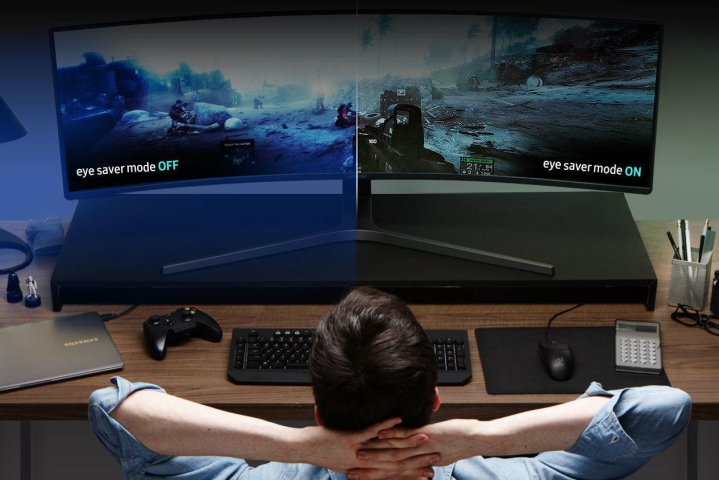
In the case of Samsung’s CHG90, it’s a mid-level DisplayHDR certified device, aka DisplayHDR 600. Tiers are based on white level performance, black level performance, and color depth performance. You can see the numbers here, but according to Samsung, HDR technology was used to increase the display’s contrast to 3,000:1. The panel is also an “industry standard-setter” with its vibrant presentation and color accuracy.
Let’s take a look at the hardware:
| Screen size: | 49 inches |
| Display type: | Vertical alignment |
| Resolution: | 3,840 x 1,080 |
| Maximum refresh rate: | 144Hz |
| Curvature: | 1800R |
| Aspect ratio: | 32:9 |
| Brightness: | 350 nits typical 250 nits minimum |
| Contrast ratio: | 3,000:1 typical 2,400:1 minimal |
| Response time: | 1ms |
| Color spaces: | sRGB 125 percent (120 percent minimal) Adobe RGB 92 percent (88 percent minimal) |
| Color support: | 1.07 billion colors |
| Color gamut: | NTSC 1978 88 percent (84 minimal) |
| GPU sync tech: | FreeSync 2 |
| Ports: | 2x HDMI 1x DisplayPort 1x Mini DisplayPort 1x 3.5mm Audio in 3x USB 3.1 Gen1 |
| Price: | $1,300 |
As the specifications show, Samsung’s desktop display is massively wide, and sports an 1800R curvature to boot. That number simply means that if the panel were to create a complete circle, the radius would be 1,800mm. It’s the typical curvature seen with desktop displays, and should encompass your entire desktop field of view given the panel’s billboard-style width.
But at its root, the CHG90 is a display designed for gamers. It supports AMD’s new FreeSync 2 technology, which will synchronize the panel’s refresh rate with the output of AMD’s Radeon graphics cards and discrete GPUs. This tech eliminates screen tearing, reduces stuttering, and minimizes the “lag” between receiving images and rendering on the screen. AMD announced FreeeSync 2 in January, which supports HDR content.
“Qualifying FreeSync 2 monitors will harness low-latency, high-brightness pixels, excellent black levels, and a wide color gamut to display high dynamic range (HDR) content.1 In addition, all FreeSync 2 monitors will have support for low framerate compensation (LFC),” the company said.
As for other game-centric features, Samsung’s CHG90 includes a game-style OSD dashboard to access display modes optimized for first-person shooters, role-playing games, real-time strategy games, and more. These modes automatically adjust color value, sharpness, black gamma levels, and contrast ratios for an optimized viewing experience while playing titles based on these genres. The display even includes backlighting that grows brighter as the game’s audio level rises.
Outside of gaming, Samsung’s display aims to eliminate your multi-monitor setup. With multiple inputs, you can view the desktops of multiple PCs on a single screen. For instance, you can partition the screen to create two equally sized windows, or create different portals of different sizes to meet your multi-tasking needs. This multi-screen feature is backed by Samsung’s Picture-by-Picture technology promising no degradation in image quality.
To purchase Samsung’s $1,300 CHG90 desktop display, head to Samsung or Amazon .
Amazon Samsung


